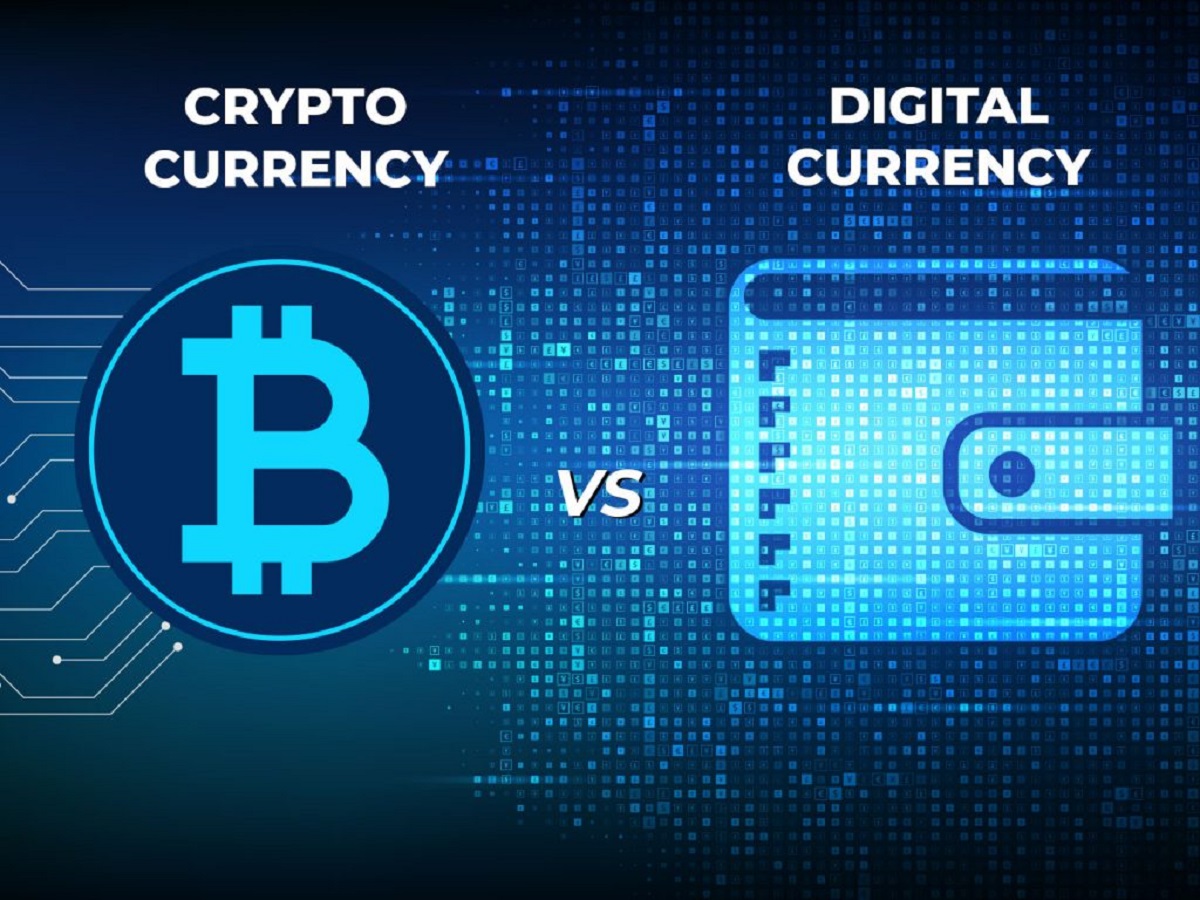Introduction
Welcome to the world of digital finance, where cryptocurrencies and digital currencies are changing the way we transact and store value. In this era of technological advancements, these terms have become increasingly common, but what exactly is the difference between cryptocurrency and digital currency?
Cryptocurrency is a type of digital or virtual currency that uses cryptography for security. It operates independently of central banks and is based on a decentralized technology known as blockchain. Bitcoin, the first and most well-known cryptocurrency, was introduced in 2009, and since then, thousands of other cryptocurrencies have emerged.
Digital currency, on the other hand, is a broader term that encompasses any form of currency or asset that exists electronically. This includes both centralized digital currencies, which are issued and controlled by a central authority, and decentralized cryptocurrencies.
While cryptocurrency and digital currency are often used interchangeably, it’s important to understand their similarities and differences. This article will delve deeper into the definitions, technologies, examples, advantages, disadvantages, and legalities of both cryptocurrency and digital currency. By the end, you’ll have a clearer understanding of these two intriguing concepts and their potential impact on our financial systems.
Definition of Cryptocurrency
Cryptocurrency is a digital or virtual currency that utilizes cryptographic technology to secure transactions and control the creation of new units. Unlike traditional currencies issued and regulated by governments, cryptocurrencies operate on decentralized systems, known as blockchains, which are distributed ledgers maintained by a network of computers.
The key feature of cryptocurrencies is their transparency and security. Transactions are recorded on the blockchain, making them immutable and resistant to fraud or unauthorized modification. This public ledger ensures trust and enables anyone to verify transactions without the need for intermediaries like banks or payment processors.
One of the main characteristics of cryptocurrencies is their limited supply. Most cryptocurrencies have a predetermined maximum supply, preventing inflation by design. Bitcoin, for example, has a limited supply of 21 million coins, ensuring scarcity and the potential for increased value over time.
Cryptocurrencies also provide pseudonymity to users, allowing them to maintain a degree of privacy in their transactions. While all transactions are recorded on the blockchain, users are identified by cryptographic addresses rather than their real names, providing a layer of anonymity.
Furthermore, cryptocurrencies offer borderless transactions, allowing users to send and receive funds across the globe without the need for traditional banking systems. This makes cryptocurrencies an attractive option for individuals and businesses engaged in international transactions.
It’s important to note that the term “cryptocurrency” encompasses a wide range of digital currencies, each with its unique features and purposes. Bitcoin, the pioneering cryptocurrency, is often seen as a store of value or a digital gold. Other cryptocurrencies, such as Ethereum, are designed to support smart contracts and decentralized applications.
In summary, cryptocurrency is a digital or virtual currency that utilizes cryptography, operates on decentralized systems, offers transparency and security, has a limited supply, provides pseudonymity, and enables borderless transactions. With these characteristics, cryptocurrencies have the potential to revolutionize the financial industry and reshape the way we transact and store value.
Definition of Digital Currency
Digital currency is a broad term used to describe any form of electronic currency or digital representation of value. Unlike traditional physical currencies such as coins or banknotes, digital currencies exist solely in electronic form, stored and transacted digitally.
Digital currencies can be divided into two main categories: centralized digital currencies and decentralized digital currencies.
Centralized digital currencies are often issued and regulated by a central authority, such as a government or a financial institution. These currencies typically operate on digital payment systems or platforms that are controlled by the issuing entity. Examples of centralized digital currencies include e-money systems like PayPal, virtual currencies used in online gaming, and digital versions of traditional fiat currencies issued by central banks.
On the other hand, decentralized digital currencies operate on distributed ledger technologies, such as blockchain, without the need for a central authority. These currencies are typically not issued or controlled by any specific entity. Instead, they rely on cryptographic principles to secure transactions and manage the creation of new units. Examples of decentralized digital currencies include cryptocurrencies like Bitcoin, Litecoin, and Ripple.
Digital currencies serve as a medium of exchange, facilitating online transactions and enabling the transfer of value between parties. They provide a digital representation of traditional currency, allowing individuals and businesses to make payments electronically. These currencies can also be used for online purchases, remittances, and micropayments.
One of the advantages of digital currencies is the speed and efficiency of transactions. Digital transactions can be processed and settled almost instantaneously, compared to traditional payment methods that may involve delays and intermediaries. This makes digital currencies especially convenient for cross-border transactions, enabling fast and low-cost transfers.
Moreover, digital currencies offer increased accessibility and financial inclusion. They provide individuals who may not have access to traditional banking services with a means to participate in the global economy. By simply having an internet connection and a digital wallet, anyone can send, receive, and store digital currencies.
In summary, digital currency refers to any form of electronic currency or digital representation of value. It encompasses both centralized digital currencies, issued and controlled by central authorities, and decentralized digital currencies, which operate on distributed ledger technologies. Digital currencies facilitate online transactions, offer speed and efficiency, increase accessibility, and have the potential to transform the way we transact in the digital age.
Similarities between Cryptocurrency and Digital Currency
While cryptocurrency and digital currency are often used interchangeably, there are several key similarities between these two forms of digital finance:
1. Digital Nature: Both cryptocurrency and digital currency exist in electronic form, allowing for seamless online transactions and storage of value. They leverage digital technologies and operate on digital payment systems.
2. Use of Cryptography: Both cryptocurrency and digital currency utilize cryptographic principles to secure transactions and protect user data. Encryption techniques ensure the authenticity and integrity of digital transactions, providing a safe and secure environment for financial transactions.
3. Online Transactions: Both forms of digital finance facilitate online transactions, allowing users to send and receive funds electronically. They enable individuals and businesses to make payments, conduct online purchases, and transfer value over the internet.
4. Borderless Nature: Cryptocurrency and digital currency enable borderless transactions and can be accessed from anywhere in the world with an internet connection. This eliminates geographical barriers and enables the seamless transfer of funds across different countries and currencies.
5. Digital Wallets: Both cryptocurrency and digital currency require users to have digital wallets to store and manage their funds. Digital wallets provide a secure way to hold and access digital currencies, allowing users to send and receive funds with ease.
6. Decentralization: While not all digital currencies are decentralized, many cryptocurrencies operate on decentralized systems, such as a blockchain. This decentralization ensures transparency, security, and resilience in the face of potential attacks or failures.
7. Alternative to Traditional Banking: Both cryptocurrency and digital currency offer an alternative to traditional banking systems. They provide individuals with the ability to participate in the global economy, even without access to traditional banking services.
These similarities demonstrate how cryptocurrency and digital currency have revolutionized the way we transact and store value in the digital age. They offer innovative solutions to traditional financial systems and provide individuals with greater control over their finances.
Differences between Cryptocurrency and Digital Currency
While cryptocurrency and digital currency share similarities, they also have distinct characteristics that set them apart:
1. Centralization: Cryptocurrencies are typically decentralized, meaning they operate on distributed ledger technologies like blockchain, which are not controlled by a central authority. In contrast, digital currencies can be both centralized, controlled by a central authority like a government or financial institution, or decentralized.
2. Regulation and Governance: Cryptocurrencies often lack regulatory oversight, as they are designed to be independent of government control. Digital currencies, especially centralized ones, are more likely to be subject to regulations and governed by specific authorities.
3. Technology: Cryptocurrencies operate on more advanced and complex technologies like blockchain, which ensures transparency, security, and decentralization. Digital currencies, especially centralized ones, typically rely on existing digital payment systems and technologies.
4. Monetary Policy: Many cryptocurrencies have a limited supply and predetermined issuance policies, ensuring a fixed or controlled inflation rate. Digital currencies, particularly those issued by central banks, can have flexible monetary policies to manage economic stability and control inflation.
5. Purpose and Functionality: Cryptocurrencies are often designed with specific functionalities beyond being a medium of exchange, such as supporting smart contract functionalities or enabling decentralized applications. Digital currencies, on the other hand, primarily serve as a digital representation of traditional currency and focus on facilitating online transactions.
6. Acceptance and Adoption: Cryptocurrencies, while gaining popularity, are still not widely accepted as a mainstream form of payment. Digital currencies, especially those issued by central authorities, are generally more widely accepted and adopted by merchants and financial institutions.
7. Volatility: Cryptocurrencies are known for their price volatility, with values that can experience significant fluctuations within short periods. Digital currencies, especially those tied to traditional government-backed currencies, tend to be more stable in value.
8. Privacy: While both cryptocurrency and digital currency transactions can offer varying degrees of privacy, cryptocurrencies typically provide a higher level of pseudonymity due to the use of cryptographic addresses. Digital currency transactions, especially centralized ones, may require more personal identification and disclosure of user information.
These differences highlight the diverse nature of cryptocurrency and digital currency. While both offer digital alternatives to traditional forms of finance, cryptocurrencies distinguish themselves through their decentralized nature, advanced technologies, and potential for transformative applications. Digital currencies, whether centralized or decentralized, primarily serve as a digital representation of traditional currency within existing financial systems.
Technology behind Cryptocurrency
The technology behind cryptocurrency is known as blockchain, a decentralized and distributed ledger that records and verifies transactions. Blockchain technology serves as the backbone for cryptocurrencies, providing transparency, security, and immutability.
At its core, a blockchain is a continuously growing chain of blocks, each containing a list of verified transactions. These blocks are linked together using cryptography, ensuring that once a block is added to the chain, it cannot be modified or removed without the consensus of the network participants.
The key components of the technology behind cryptocurrency are:
1. Decentralization: Cryptocurrencies operate on decentralized networks of computers, known as nodes, spread across the globe. Each node maintains a copy of the blockchain, ensuring that no single entity has control over the entire system. This decentralized structure enhances security, resistance to censorship, and enables transparent and trustless transactions.
2. Consensus Mechanisms: In a decentralized network, consensus mechanisms are used to validate and agree upon the state of the blockchain. Popular consensus mechanisms include Proof of Work (PoW) and Proof of Stake (PoS). PoW requires participants, known as miners, to solve complex mathematical puzzles to add new blocks to the blockchain. PoS, on the other hand, selects block validators based on the number of coins they hold and are willing to “stake” as collateral.
3. Cryptography: Cryptography plays a pivotal role in securing transactions and ensuring the integrity of the blockchain. It involves the use of cryptographic algorithms, such as hashing and digital signatures, to authenticate and encrypt data. These cryptographic techniques make the blockchain resistant to tampering and fraud.
4. Smart Contracts: Smart contracts are self-executing contracts with predefined terms and conditions written directly into the code of the blockchain. They automatically enforce agreements between parties without the need for intermediaries. Smart contracts enable the creation of decentralized applications (DApps) and various functionalities beyond simple transactions.
5. Mining: Mining is the process by which new cryptocurrency units are created and transactions are verified and added to the blockchain. Miners use computational power to solve complex mathematical puzzles, which requires significant computational resources and energy consumption. In return for their efforts, miners are rewarded with a portion of the newly created cryptocurrency.
6. Privacy and Anonymity: While the blockchain provides transparency, most cryptocurrencies offer varying degrees of privacy and anonymity. Techniques such as zero-knowledge proofs and encryption protocols are employed to protect users’ identities and transaction details while maintaining the integrity of the blockchain.
The technology behind cryptocurrency has had a profound impact on finance, governance, and various industries. Its decentralized and transparent nature has the potential to disrupt traditional financial systems and enable new business models and applications.
Technology behind Digital Currency
The technology behind digital currencies varies depending on whether it is centralized or decentralized. Centralized digital currencies typically operate on existing digital payment systems and technologies, while decentralized digital currencies leverage similar technologies as cryptocurrencies, such as blockchain.
Centralized Digital Currency: Centralized digital currencies, such as e-money systems or digital versions of traditional fiat currencies, rely on established digital payment systems. These systems are controlled and operated by central authorities, such as governments or financial institutions. They utilize databases and digital infrastructure to facilitate transactions and store user account balances.
These systems often employ encryption and security measures to protect user information and ensure transaction integrity. However, the underlying technology used is not as complex or decentralized as blockchain. Examples of centralized digital currency systems include PayPal, Venmo, and digital versions of national currencies like the digital yuan or digital euro.
Decentralized Digital Currency: Decentralized digital currencies, similar to cryptocurrencies, often utilize blockchain technology. However, not all decentralized digital currencies are based on blockchain; they may employ alternative distributed ledger technologies.
The decentralized nature of digital currencies ensures transparency, security, and immutability of transactions. Distributed ledger technologies like blockchain enable a network of participants to reach consensus on the validity of transactions and the state of the ledger. This eliminates the need for intermediaries and provides a trustless environment for peer-to-peer transactions.
Decentralized digital currencies can also incorporate smart contract functionality, enabling the execution of self-executing contracts without the involvement of third parties. These contracts automatically execute predefined actions when certain conditions are met, further enhancing the functionality and versatility of decentralized digital currency systems.
Privacy and anonymity features may vary across decentralized digital currency systems. While some may offer more pseudonymity, allowing users to transact without revealing their identities, others may prioritize identity verification for compliance and regulatory purposes.
Examples of decentralized digital currencies include Bitcoin, Ethereum, and other cryptocurrencies that operate on their respective blockchains.
It’s important to note that the technology behind digital currencies is constantly evolving. New advancements, such as privacy protocols, scalability solutions, and interoperability frameworks, continue to shape the landscape of digital currencies and enhance their functionality.
In summary, the technology behind digital currency varies depending on whether it is centralized or decentralized. Centralized digital currencies rely on existing digital payment systems, while decentralized digital currencies often leverage blockchain or other distributed ledger technologies to provide transparency, security, and peer-to-peer transactions without the need for intermediaries.
Examples of Cryptocurrencies
The world of cryptocurrencies is vast and continuously expanding, with thousands of different cryptocurrencies available. Here are some notable examples:
1. Bitcoin (BTC): Bitcoin is the pioneering cryptocurrency, introduced in 2009 by an anonymous person or group known as Satoshi Nakamoto. It operates on a decentralized blockchain and is often referred to as digital gold. Bitcoin has the largest market capitalization and has paved the way for the development of other cryptocurrencies.
2. Ethereum (ETH): Ethereum is an open-source platform that enables the creation of decentralized applications (DApps) and smart contracts. It operates on its native cryptocurrency called Ether. Ethereum introduced the concept of programmable blockchain, allowing developers to build and deploy their own applications on top of it.
3. Ripple (XRP): Ripple is both a digital payment protocol and a cryptocurrency. It focuses on facilitating instant and low-cost international money transfers. Ripple’s native token, XRP, is used within the Ripple network to facilitate transactions and provide liquidity.
4. Litecoin (LTC): Created by Charlie Lee in 2011, Litecoin is often referred to as the “silver” to Bitcoin’s “gold.” It is a peer-to-peer cryptocurrency that offers faster transaction confirmation times and a different hashing algorithm compared to Bitcoin. Litecoin aims to be a digital currency for everyday transactions.
5. Bitcoin Cash (BCH): Bitcoin Cash is a cryptocurrency that emerged as a result of a hard fork from the original Bitcoin network. It was created to address scalability issues and increase transaction throughput. Bitcoin Cash aims to be a more practical and efficient digital currency for everyday use.
6. Cardano (ADA): Cardano is a blockchain platform that aims to provide a secure and sustainable platform for the development of decentralized applications and smart contracts. The native cryptocurrency of Cardano is called ADA. Cardano’s blockchain incorporates a scientific approach and aims to offer scalability, security, and regulatory compliance.
7. Binance Coin (BNB): Binance Coin is the native cryptocurrency of the Binance exchange, one of the largest cryptocurrency exchanges globally. BNB is used to pay for transaction fees on the Binance platform and participate in token sales conducted on the exchange.
8. Polkadot (DOT): Polkadot is a multi-chain platform that enables different blockchains to interoperate, share information, and communicate with each other. DOT is the native cryptocurrency of the Polkadot network and is used for governance and bonding within the network.
9. Chainlink (LINK): Chainlink is a decentralized oracle network that connects smart contracts with real-world data and external APIs. The LINK token is used to incentivize node operators and facilitate data transfer and access between smart contracts and off-chain sources.
10. Stellar (XLM): Stellar is a blockchain-based platform that aims to enable fast and low-cost cross-border transactions. It focuses on providing financial access and inclusion to underserved populations. The native cryptocurrency of Stellar is called Lumens (XLM) and is used for transaction fees and as a bridge currency.
These examples represent just a fraction of the diverse range of cryptocurrencies available. Each cryptocurrency has its unique features, use cases, and goals, showcasing the innovation and potential of this emerging asset class.
Examples of Digital Currencies
Digital currency encompasses a wide range of electronic currencies, including both centralized and decentralized forms. Here are some examples:
1. PayPal: PayPal is a widely used online payment system that allows users to send and receive money electronically. It operates as a centralized digital currency, providing a convenient and secure platform for online transactions.
2. Venmo: Venmo is a mobile payment service that enables users to send money to friends and family. It offers a social element, allowing users to share payment details and interact with contacts on the platform. Venmo operates as a centralized digital currency system.
3. WeChat Pay: WeChat Pay is a digital payment platform integrated into the popular Chinese messaging app, WeChat. It allows users to make payments, transfer money, and even hail taxis within the app. WeChat Pay is widely accepted in China and operates as a centralized digital currency system.
4. Alipay: Alipay is a mobile and online payment platform in China operated by Ant Group, an affiliate of Alibaba Group. It offers a wide range of services, including contactless payments, money transfers, and online shopping. Alipay operates as a centralized digital currency system.
5. Digital versions of fiat currencies: Many countries are exploring or implementing digital versions of their fiat currencies. These digital currencies are designed to mimic the properties of physical currency but exist only in electronic form. Examples include the digital yuan in China, the digital euro in the Eurozone, and the digital dollar being considered in the United States.
6. Facebook’s Diem (formerly Libra): Diem, formerly known as Libra, is a digital currency project initiated by Facebook. It aims to provide a global digital currency that can be used for online transactions across various platforms and applications. Diem is expected to operate as a centralized digital currency system.
7. Tether (USDT): Tether is a stablecoin that pegs its value to a traditional currency, typically the U.S. dollar. It operates on the Bitcoin blockchain or other blockchain networks and is designed to provide stability and liquidity in the cryptocurrency market. Tether is a decentralized digital currency.
8. eToroX’s digital currencies: eToroX, a subsidiary of the popular trading platform eToro, has introduced a range of digital currencies that are used within their ecosystem. These digital currencies enable instant and secure transactions within the eToroX network.
9. DigixDAO (DGX): DigixDAO is a digital currency project backed by physical gold. Each DGX token represents ownership of one gram of gold, providing a digital representation of a tangible asset. DigixDAO operates as a decentralized digital currency.
10. Mobile network operator digital currencies: Some mobile network operators have ventured into the digital currency space by offering their own digital currencies. For example, M-Pesa in Kenya allows users to send and receive money via their mobile phones, effectively acting as a digital currency for financial transactions.
These examples illustrate the diversity of digital currencies available, ranging from centralized systems offered by payment service providers to decentralized cryptocurrencies backed by tangible assets. The adoption and use of digital currencies continue to evolve as technology advances and the demand for digital transactions grows.
Advantages of Cryptocurrency
Cryptocurrencies offer several advantages that contribute to their growing popularity and potential impact on the financial landscape:
1. Decentralization: Cryptocurrencies operate on decentralized networks, eliminating the need for intermediaries such as banks or payment processors. This decentralization provides greater control and ownership over funds, reducing the risk of censorship, interference, or seizure of assets.
2. Security: Cryptocurrencies use cryptographic techniques to secure transactions and user funds. The decentralized nature of blockchain technology makes it resistant to hacking and fraud attempts. Additionally, users have control over their private keys, enhancing the security of their digital assets.
3. Transparency: Cryptocurrency transactions are recorded on a public blockchain, allowing anyone to view and verify transactions. This transparency fosters trust among users and reduces the potential for fraudulent activities.
4. Accessibility: Cryptocurrencies provide financial inclusion to individuals who may not have access to traditional banking services. With just an internet connection, users can participate in the global economy, send and receive funds, and store value without the need for a bank account.
5. Speed and Efficiency: Cryptocurrency transactions can be processed quickly and settled almost instantly, particularly when compared to traditional banking systems. This enables efficient cross-border transactions, removes the need for intermediaries, and reduces transfer fees and processing times.
6. Lower Transaction Costs: Cryptocurrency transactions often have lower fees compared to traditional payment methods, especially for cross-border transfers. With no intermediaries involved, users can save on transaction fees and enjoy more cost-effective transactions.
7. Innovation and Potential: The emergence of cryptocurrencies has brought about innovative technologies and applications. Blockchain technology, which underpins most cryptocurrencies, has the potential to transform various industries beyond finance, such as supply chain management, voting systems, and decentralized applications.
8. Investment Opportunities: Cryptocurrencies have opened up new investment opportunities for individuals and institutions. Early adopters of cryptocurrencies have witnessed significant returns on their investments, with the market offering the potential for high volatility and substantial gains.
9. Financial Control: Cryptocurrencies allow individuals to have full control and ownership of their funds. They can manage and store their assets in digital wallets without reliance on third parties. This control over financial assets aligns with the principles of economic sovereignty and personal empowerment.
10. Global Accessibility: Cryptocurrencies seamlessly transcend borders, enabling individuals to transact with anyone worldwide without the need for currency conversions or intermediaries. This global accessibility promotes cross-border trade and financial cooperation.
These advantages demonstrate the transformative potential of cryptocurrencies to reshape the financial industry, promote financial inclusion, and empower individuals with greater control and access to their funds.
Advantages of Digital Currency
Digital currency offers numerous advantages that have contributed to its widespread adoption and integration into the global financial ecosystem:
1. Convenience and Efficiency: Digital currency enables quick and seamless online transactions. With just a few clicks, users can send and receive funds, make purchases, and complete financial transactions, eliminating the need for physical cash or traditional banking methods. This convenience and efficiency increase the speed and ease of financial interactions.
2. Cost Savings: Digital currency transactions often incur lower fees compared to traditional payment methods. With reduced overhead costs and intermediaries, digital currency transactions can be significantly cheaper, benefiting both businesses and individuals.
3. Accessibility: Digital currency provides greater financial inclusion, allowing anyone with internet access and a digital wallet to participate in the global economy. This opens up opportunities for those without access to traditional banking services, enabling them to transact, save, and invest without the limitations posed by physical currencies.
4. Global Transactions: With digital currency, geographical borders are no longer barriers to financial interactions. Individuals and businesses can transact with anyone, anywhere in the world, eliminating the complexities and costs associated with exchanging currencies and navigating international banking systems.
5. Security: Digital currency transactions are secure and encrypted, reducing the risk of fraud, counterfeiting, or identity theft. Blockchain technology, often used in digital currency systems, provides transparency and immutability, making transactions traceable and tamper-proof.
6. Privacy: Digital currency offers varying levels of privacy, allowing users to maintain control over their financial information. While some digital currency transactions require user identification, others provide greater pseudonymity and anonymity, ensuring the privacy and confidentiality of transactions.
7. Financial Control: Digital currency empowers individuals with greater control over their finances. Users have direct ownership and control of their digital wallets and funds, eliminating the need to rely on intermediaries like banks. This control aligns with principles of economic sovereignty and personal empowerment.
8. Micropayments and Microtransactions: Digital currency facilitates micropayments and microtransactions, enabling the exchange of small amounts of value quickly and economically. This opens up new possibilities for content monetization, subscription services, and machine-to-machine transactions.
9. Programmability: Some digital currencies, particularly those operating on programmable blockchain platforms, allow for the development of smart contracts and decentralized applications (DApps). These programmable capabilities enhance the functionality and potential use cases of digital currency, enabling more complex financial interactions.
10. Innovation and Future Potential: Digital currency serves as a catalyst for innovation and drives the development of new financial technologies. As the field continues to evolve, the potential applications of digital currency expand, paving the way for improved financial systems, economic growth, and disruptive business models.
The advantages of digital currency highlight its transformative potential, increasing financial accessibility, efficiency, and security while providing individuals and businesses with greater control over their finances and enabling seamless global transactions.
Disadvantages of Cryptocurrency
While cryptocurrencies offer numerous advantages, they also present certain disadvantages that need to be considered:
1. Price Volatility: Cryptocurrencies are highly volatile, with prices that can fluctuate dramatically within short periods. This volatility can pose significant risks for investors and may deter individuals from using cryptocurrencies as a stable medium of exchange.
2. Regulatory Uncertainty: The regulatory environment surrounding cryptocurrencies is still evolving, leading to uncertainty and lack of clarity in many jurisdictions. This can create challenges for businesses and individuals in terms of compliance and legal obligations.
3. Security Concerns: While the technology behind cryptocurrencies is secure, the same cannot always be said for the platforms and exchanges that facilitate their trading. Hacks, thefts, and scams have occurred in the cryptocurrency industry, leading to the loss of user funds and eroding trust in the ecosystem.
4. Irreversibility of Transactions: Once a cryptocurrency transaction is executed and verified on the blockchain, it is typically irreversible. While this enhances security and prevents fraud, it also means that any accidental or erroneous transactions cannot easily be reversed, resulting in potential financial losses.
5. Limited Acceptance: Despite growing adoption, cryptocurrencies still have limited acceptance as a medium of exchange. Many merchants and service providers do not accept cryptocurrencies as a form of payment, which restricts their practical use in day-to-day transactions.
6. Technical Complexity: Cryptocurrencies and their underlying technology can be complex for individuals who are not familiar with the technical aspects. The process of acquiring, storing, and transacting with cryptocurrencies may require a certain level of technical expertise and can be challenging for newcomers.
7. Energy Consumption: Some cryptocurrencies, particularly those that rely on proof-of-work consensus mechanisms, require significant amounts of computational power and energy consumption. The environmental impact of this energy consumption has raised concerns about the sustainability of certain cryptocurrency networks.
8. Lack of Customer Support: Cryptocurrency transactions often do not come with the same level of customer support and dispute resolution mechanisms as traditional banking systems. This can pose challenges for users who encounter issues with their transactions or require assistance.
9. Potential for Illegal Activities: Cryptocurrencies have been associated with illegal activities due to their pseudonymous nature and lack of centralized control. They can be used for money laundering, tax evasion, and illicit transactions, which has led to concerns among regulators and the need for increased scrutiny.
10. Dependency on Technology: Cryptocurrency transactions rely on technology infrastructure, including internet connectivity and digital wallets. Any disruption or failure of these systems can temporarily hinder the ability to transact with cryptocurrencies.
These disadvantages highlight the challenges and risks associated with cryptocurrencies. As the industry continues to mature, efforts are being made to address these issues and increase the adoption and acceptance of cryptocurrencies as a reliable and widely used form of digital finance.
Disadvantages of Digital Currency
While digital currency offers various advantages, there are also certain disadvantages that need to be taken into consideration:
1. Centralization: Many digital currencies are operated and controlled by central authorities, such as governments or financial institutions. This centralization can lead to concerns about data privacy, censorship, and the potential for abuse of power.
2. Security Risks: Digital currencies, especially centralized systems, can be vulnerable to security breaches and cyberattacks. Hackers may target digital currency platforms and wallets, potentially resulting in the loss or theft of user funds.
3. Dependence on Technology: The use of digital currencies relies heavily on technological infrastructure, such as internet connectivity and digital wallets. Any disruptions or technical issues in these systems can temporarily impede the ability to transact with digital currencies.
4. Loss of Physical Cash: The shift to digital currency means that physical cash is no longer used in transactions. While this offers convenience and efficiency, it also poses challenges for individuals who may prefer or rely on physical currency for various reasons.
5. Lack of Universal Acceptance: Digital currencies, particularly newer or less widely adopted ones, often face limited acceptance as a form of payment. Many businesses and merchants do not yet accept digital currencies, which restricts their usefulness in everyday transactions.
6. Lack of Regulation: The regulatory landscape for digital currencies is still developing and can vary significantly between jurisdictions. This lack of clear regulations may lead to uncertainty for individuals and businesses in terms of legal compliance and consumer protections.
7. Potential for Fraud and Scams: The anonymous and decentralized nature of some digital currencies can make them attractive targets for fraudsters and scammers. Users may be susceptible to phishing attempts, Ponzi schemes, and fraudulent initial coin offerings (ICOs) that aim to deceive and defraud individuals.
8. Financial Loss Due to Errors: Digital transactions can be subject to human errors, such as entering incorrect wallet addresses or making accidental transfers. Unlike traditional banking systems, where some transactions can be reversed or corrected, digital currency transactions are typically irreversible, potentially resulting in permanent financial loss.
9. Limited Customer Support: Digital currency transactions often do not provide the same level of customer support as traditional banking systems. Users may encounter challenges in resolving issues, recovering lost funds, or receiving timely assistance in case of technical difficulties or disputes.
10. Potential for Economic Inequality: With digital currency, individuals who do not have access to digital infrastructure or the required technological resources may be left behind. This digital divide can exacerbate existing economic inequalities and hinder financial inclusion.
These disadvantages highlight the challenges and risks associated with the increasing reliance on digital currency. As digital currency evolves, efforts should be made to address these concerns and ensure a secure, inclusive, and regulated digital financial ecosystem.
Regulation and Legalities of Cryptocurrency
The regulation and legalities surrounding cryptocurrencies vary significantly across different jurisdictions. While some countries have embraced cryptocurrencies and established regulatory frameworks, others have taken a more cautious approach. Here are key aspects regarding the regulation and legalities of cryptocurrency:
1. Lack of Uniformity: There is currently no standardized global regulation for cryptocurrencies. Different countries and regions apply varying approaches, ranging from outright bans to supportive regulatory frameworks. This lack of uniformity creates challenges and uncertainties for individuals and businesses operating in the cryptocurrency space.
2. Regulatory Categories: Regulatory approaches towards cryptocurrencies typically fall into three main categories: acceptance, regulation, and prohibition. Some countries, like the United States, have accepted cryptocurrencies as a legitimate form of payment and subject them to specific regulations. Others, such as Japan and Switzerland, have implemented comprehensive regulatory frameworks to protect consumers and promote innovation. Meanwhile, a few countries, including China and India, have imposed restrictions or even banned cryptocurrencies outright.
3. Consumer Protection: Many jurisdictions aim to protect consumers by establishing regulations on cryptocurrency exchanges and service providers. These regulations can include measures to combat fraud, ensure transparent operations, and enforce compliance with anti-money laundering (AML) and know-your-customer (KYC) requirements.
4. Taxation: The taxation of cryptocurrencies varies across different countries. Governments have developed different approaches to taxing cryptocurrencies, including treating them as assets subject to capital gains tax or as a form of currency for goods and services. It is important for individuals and businesses to understand their tax obligations regarding cryptocurrency transactions in their respective jurisdictions.
5. Security Regulations: Some jurisdictions have implemented security regulations for cryptocurrency exchanges and wallets. These regulations aim to protect against cyberattacks, data breaches, and theft. Compliance with security measures, such as multi-factor authentication and cold storage of digital assets, may be required for cryptocurrency service providers.
6. Initial Coin Offerings (ICOs): ICOs, the crowdfunding method used by many blockchain projects, have come under scrutiny in numerous jurisdictions. Regulatory authorities in certain countries have taken measures to protect investors, such as requiring ICO issuers to comply with securities regulations and provide detailed information about their projects and token offerings.
7. International Coordination: Given the borderless nature of cryptocurrencies, regulators around the world are recognizing the need for international coordination. Organizations like the Financial Action Task Force (FATF) work to develop international standards and encourage cooperation in combating money laundering and terrorism financing involving cryptocurrencies.
8. Evolving Landscape: The regulatory landscape for cryptocurrencies continues to evolve as governments and regulatory bodies gain a deeper understanding of the technology and its implications. Authorities are increasingly exploring approaches to strike a balance between protecting investors and consumers, while also fostering innovation and financial inclusion.
9. Compliance Challenges: The complexity of cryptocurrency regulations poses compliance challenges for individuals and businesses operating in multiple jurisdictions. Navigating through varying regulations and ensuring compliance with AML, KYC, and tax requirements can be demanding and costly.
10. Future Outlook: As cryptocurrencies continue to gain traction and the technology matures, it is expected that regulatory frameworks will continue to develop and evolve. It is crucial for industry participants to stay informed about changes in regulations and engage in constructive discussions with regulators to shape a regulatory environment that fosters innovation and safeguards the interests of all stakeholders.
Overall, the regulation and legalities surrounding cryptocurrencies vary and are constantly evolving. Individuals and businesses involved in the cryptocurrency ecosystem should familiarize themselves with the regulatory landscape of their respective jurisdictions to ensure compliance and mitigate potential risks.
Regulation and Legalities of Digital Currency
The regulation and legalities surrounding digital currency vary across different jurisdictions. While some countries have established comprehensive frameworks, others are still in the process of defining regulations. Here are key aspects regarding the regulation and legalities of digital currency:
1. Regulatory Approaches: Different countries adopt varied regulatory approaches towards digital currency. Some have embraced digital currency, creating specific legal frameworks and licensing requirements for digital currency service providers. Others are cautiously monitoring the technology’s impact and considering appropriate regulatory measures.
2. Consumer Protection: Many jurisdictions focus on protecting consumers by implementing regulations related to digital currency transactions, wallets, and exchanges. These regulations aim to prevent fraud, ensure fair practices, and safeguard the interests of users. Consumer protection laws and regulations, such as anti-money laundering (AML) and know-your-customer (KYC) requirements, may also apply to digital currency services.
3. Central Bank Digital Currency (CBDC): Some countries are exploring or developing central bank digital currencies, which are government-issued digital currencies that operate within a regulated framework. These CBDCs aim to provide the benefits of digital currency while maintaining centralized control and oversight by central banks.
4. Taxation: Taxation regulations for digital currency transactions vary across jurisdictions. Governments categorize digital currency for tax purposes, with some considering it as a form of currency, while others treat it as an asset subject to capital gains tax. Individuals and businesses involved in digital currency transactions must understand and comply with the tax regulations in their respective jurisdictions.
5. Financial Stability: Regulators and central banks monitor digital currency and its potential impact on financial stability and monetary policy. They assess the risks associated with digital currency activities, such as money laundering, terrorist financing, and the effects on the traditional banking system.
6. Cross-border Transactions: The global nature of digital currency transactions raises challenges for regulatory oversight and cross-border cooperation. Regulators strive to develop methods of international coordination to combat illicit activities and ensure compliance with regulations, particularly in areas such as AML and KYC.
7. Privacy and Data Protection: Regulations regarding data protection and privacy are also applicable to digital currency transactions. Regulators may require digital currency service providers to comply with data protection laws, ensuring the secure handling of personal and financial information.
8. Innovation and Sandbox Approaches: Several jurisdictions have introduced regulatory sandboxes and innovation hubs to encourage the development of digital currency technology. These initiatives provide a controlled environment where startups and businesses can test and develop their digital currency solutions, while regulators observe and provide necessary guidance.
9. International Standards: Organizations such as the Financial Action Task Force (FATF) work towards establishing international standards and guidelines for digital currency regulation. Their aim is to combat money laundering, terrorist financing, and other illicit activities while fostering innovation and financial inclusion.
10. Evolving Landscape: Given the rapid advancements in digital currency technology, regulatory frameworks are continuously evolving. Regulators adapt to new challenges and opportunities presented by emerging technologies with the goal of striking a balance between innovation, consumer protection, and financial stability.
It is important for individuals, businesses, and policymakers to stay informed about the regulatory landscape surrounding digital currency. Compliance with applicable regulations promotes consumer trust, safeguards against risks, and fosters the responsible development and use of digital currency.
Future of Cryptocurrency
The future of cryptocurrency is filled with exciting possibilities and potential for further transformative impact on various aspects of our lives and financial systems. Here are some key factors shaping the future of cryptocurrency:
1. Mainstream Adoption: As awareness and understanding of cryptocurrency grow, we can expect increased adoption by individuals, businesses, and even governments. Mainstream companies are integrating cryptocurrency into their offerings, and more merchants are accepting cryptocurrency as a form of payment, paving the way for broader acceptance and usage.
2. Institutional Investment: Increasingly, institutional investors, including banks, hedge funds, and asset management firms, are entering the cryptocurrency market. This influx of institutional investment is contributing to greater liquidity, stability, and maturation within the cryptocurrency ecosystem.
3. Regulatory Frameworks: Regulatory frameworks around the world are evolving to address the unique challenges and opportunities presented by cryptocurrencies. As regulators strive to strike a balance between innovation and consumer protection, clearer, more comprehensive regulatory frameworks are likely to emerge. These frameworks will bring greater clarity and stability to the cryptocurrency market.
4. Advancements in Technology: The technology driving cryptocurrencies, such as blockchain, continues to advance at a rapid pace. Scalability and interoperability solutions are being developed to address the limitations of current blockchain networks, enhancing transaction speeds and efficiency. Additionally, advancements in privacy and security measures are being explored, addressing concerns and making cryptocurrencies more robust.
5. Central Bank Digital Currencies (CBDCs): The rise of central bank digital currencies is a significant development in the cryptocurrency landscape. Central banks across the world are exploring and experimenting with CBDCs, aiming to offer a digital version of traditional fiat currencies. CBDCs have the potential to streamline financial systems, improve efficiency, and enhance financial inclusion.
6. Integration of Smart Contracts: The integration of smart contract functionality into cryptocurrencies opens up a world of possibilities. Smart contracts enable self-executing agreements with pre-coded conditions, eliminating the need for intermediaries and enabling automated, trustless transactions. This technology has the potential to revolutionize sectors such as supply chain management, real estate, and decentralized finance (DeFi).
7. Enhanced Financial Inclusion: Cryptocurrencies can play a vital role in providing financial services to the unbanked and underbanked populations globally. The borderless nature of cryptocurrency transactions, coupled with the growing availability of mobile devices, can bridge gaps in financial access and empower individuals who have traditionally been excluded from traditional banking systems.
8. Interoperability and Cross-Chain Solutions: Interoperability solutions are being developed to enable seamless communication and interoperability between different blockchain networks. These solutions aim to break down silos and create a connected ecosystem of blockchains, allowing for more efficient and streamlined exchange of value and data.
9. Evolution of Stablecoins: Stablecoins, which aim to maintain a stable value by pegging to an external asset, have gained traction in the cryptocurrency market. As stablecoins continue to evolve and improve their transparency and auditability, they could potentially become a bridge between traditional finance and the cryptocurrency ecosystem, facilitating seamless value transfer and reducing volatility concerns.
10. Global Financial Transformation: Cryptocurrencies have the potential to revolutionize the global financial landscape. They can reduce the dependency on traditional banking systems, enable faster and cheaper cross-border transactions, and empower individuals with greater control over their finances. By introducing financial systems built on programmable digital assets, cryptocurrencies are poised to reshape the way we store and transact value.
While challenges and uncertainties remain, the future of cryptocurrency is filled with promise and the potential to drive significant changes in how we engage with finance, technology, and the global economy.
Future of Digital Currency
The future of digital currency is poised for significant advancements and transformative changes in the way we perceive and interact with money and financial systems. Here are key factors that will shape the future of digital currency:
1. Central Bank Digital Currencies (CBDCs): Central banks around the world are exploring the development of CBDCs, which are digital representations of traditional fiat currencies. CBDCs have the potential to provide a more efficient and inclusive financial system, enabling faster transactions, reducing costs, and expanding financial access to underserved populations.
2. Adoption and Mainstream Integration: As the digital economy continues to expand, the adoption and integration of digital currency are likely to accelerate. Businesses, financial institutions, and individuals will increasingly incorporate digital currency into their everyday transactions and financial operations, driving wider acceptance and usage.
3. Enhanced Payment Systems: Digital currency is set to revolutionize payment systems, making transactions faster, more secure, and more accessible. Peer-to-peer transactions can become instant and borderless, eliminating the need for intermediaries and reducing transaction costs. Additionally, innovations such as near-field communication (NFC) and contactless payment technologies will further enhance the efficiency of digital currency transactions.
4. Development of Stablecoins: Stablecoins, digital currencies pegged to external assets like fiat currencies or commodities, offer stability and reduce the volatility often associated with cryptocurrencies. The increased development and adoption of stablecoins will provide more confidence and encourage their use in everyday transactions, bridging the gap between traditional finance and the digital currency ecosystem.
5. Interoperability and Cross-Platform Integration: Interoperability solutions and cross-platform integration will be key areas of development in the future of digital currency. Creating seamless communication and connectivity between different digital currency platforms and payment systems will enable the seamless transfer of value across various ecosystems, fostering greater financial inclusion and supporting global transactions.
6. Integration with Internet of Things (IoT) and Smart Devices: The integration of digital currency with IoT and smart devices will enable machine-to-machine microtransactions. Smart devices will have built-in wallets and the capability to initiate and automate digital currency transactions, creating new opportunities for the machine economy.
7. Privacy and Security: Advancements in privacy-focused technologies and security measures will be crucial in driving the future of digital currency. Solutions such as zero-knowledge proofs, homomorphic encryption, and decentralized identity management will address concerns about privacy while maintaining the necessary level of security to safeguard digital assets and personal information.
8. Regulatory Frameworks: Governments and regulatory authorities will continue to develop and refine regulatory frameworks for digital currency. Regulations will focus on consumer protection, anti-money laundering (AML), and fraud prevention, striking a balance between fostering innovation and ensuring compliance with legal requirements.
9. Financial Inclusion and Accessible Banking Services: Digital currency will play a significant role in expanding financial inclusion, allowing individuals without access to traditional banking services to participate in the global economy. Digital currency offers an opportunity to provide essential financial services to the unbanked and underbanked populations across the world.
10. Collaboration and Standardization: Collaboration between industry stakeholders, governments, and international organizations will drive the future of digital currency. Efforts to standardize terminology, technical specifications, and interoperability will promote a cohesive and interoperable digital currency ecosystem.
The future of digital currency holds immense potential for revolutionizing the financial landscape, driving financial innovation, and empowering individuals with greater control over their finances. As advancements and adoption continue, digital currency will transform how we store, transact, and perceive value in the digital era.
Conclusion
The world of digital currency and cryptocurrency is continuously evolving, offering unique advantages and challenges. Digital currency encompasses a broad range of electronic currencies, both centralized and decentralized, that are reshaping the way we transact and store value. Cryptocurrencies, operating on decentralized systems like blockchain, provide transparency, security, and financial control, while offering the potential for borderless transactions and financial inclusion.
Advancements in technology, including interoperability solutions and the integration of smart contracts, are driving the future of digital currency, facilitating faster transactions, reduced costs, and increased financial accessibility. Central bank digital currencies (CBDCs) are emerging as a transformative force, presenting opportunities for improved financial systems and inclusive access to digital finance.
However, the adoption and regulation of digital currency and cryptocurrencies remain in a dynamic state. Regulatory frameworks are still being developed, varying across jurisdictions, and seeking to strike a balance between innovation and consumer protection. Challenges such as price volatility, security risks, and regulatory uncertainties need to be addressed for the wide-scale adoption and acceptance of digital currency.
As we move forward, collaboration between industry stakeholders, governments, and international organizations will be essential in shaping a standardized and interoperable digital currency ecosystem. The integration of digital currency with emerging technologies like the Internet of Things (IoT) and privacy-enhancing solutions will further unlock its potential and open new avenues for economic growth and financial empowerment.
The future of digital currency is promising, with potential benefits ranging from financial inclusion and access to new investment opportunities, to greater efficiency and convenience in financial transactions. As the world embraces the possibilities and overcomes the challenges, digital currency will continue to reshape the financial landscape, empowering individuals and revolutionizing the way we transact and interact with money.

























